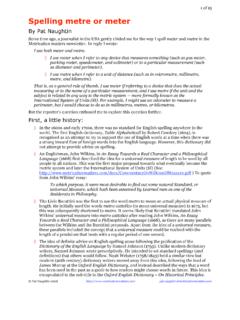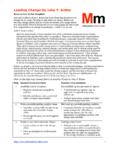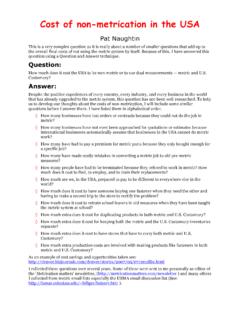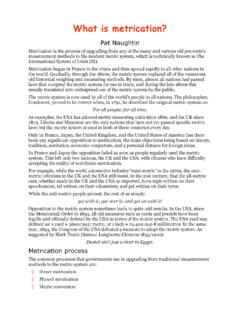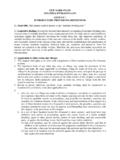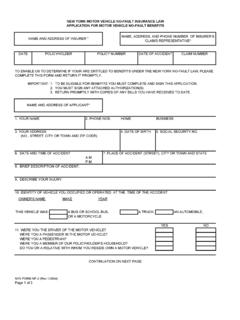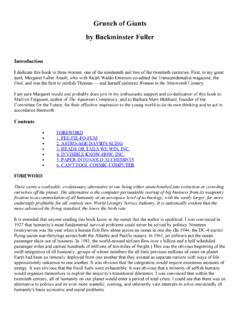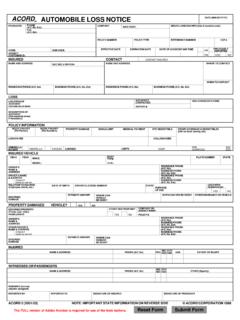Transcription of Walking for Fitness - Metrication
1 1 of 7 Pat Naughtin 2005 Walking for Fitness Your metric guide to Walking for Fitness or to reduce your body mass The first stage in getting fitter and reducing your body mass may not be starting another diet. It might be as simple as going for a walk. People often worry about how much food energy they take in, but then they forget about, or ignore, the other side of the same issue how much of their food energy goes out. Using more food energy by increasing your activity might be a more successful way for you to decrease you body mass, without any pills or diets. Even if your body mass doesn't change, you will definitely feel fitter if you develop and follow your own Walking program.
2 Walking also helps you shift your attitude toward your health, your Fitness , and your body mass. Plan on taking a full year to move through the 3 stage program below. This means taking a leisurely 4 months for each stage. Don't rush change won't happen overnight. Stage 1: Just get out and walk Your Walking goals are to find opportunities through your day to go for short walks. to enjoy your walks. to feel invigorated and happy after each walk. to realise that speed is not important during this first stage. to recognise if your walks are becoming painful in any way and if so to cut back immediately; you don t have to hurt to feel better.
3 To plan positive but gradual lifestyle changes that include a 10 minute walk each day. to develop the habit of 'going for a walk' every day. 2 of 7 Pat Naughtin 2005 Tips, notes, and suggestions Build a daily Walking habit. Think of it as being more active than you used to be. Don t change your clothes; don't go to a gym; and definitely don't jump around for hours. Just take a short walk to the bus stop, the mailbox, or the local store for some bread or milk. In the beginning how far (or how fast) you walk isn't important. What is important is simply going for short walks on most days of the week. Be careful not to overdo it once you start regular Walking , you ll want to walk further.
4 If you like numbers, buy and wear a pedometer to count your paces. Find ways to add a minimum of an extra 1 000 paces into your daily activities. A 10 minute walk at about 120 paces per minute is 1 200 paces. You might even like to break that up into 2 five minute walks of 600 paces each. Your overall goal in Stage 1 is to develop the habit of 'going for a walk' every day. Note that this program doesn't give you a choice about how often you walk every day is the right time to take a short walk. Plan for poor weather. Walk around a shopping mall. Walk from end to end of a large office, factory, or warehouse. Stage 2: Walk further and for longer Your Walking goals are to continue to find new opportunities to go for short walks.
5 To walk more vigorously but still feel happy after each walk. to recognise if your walks are becoming painful in any way and if so to cut back immediately; you don t have to hurt to feel better. to gradually increase to a minimum of 20 minutes Walking each day and then to slowly increase the walk on one day each week to 40 minutes. A gradual increase is by about 10 % each week. Tips, notes, and suggestions As you start to increase your Walking distance you ll begin to feel fitter and you might also begin to see that your body mass is reducing. If you don't see a reduction in your body mass, it may be because you are building muscle muscle is heavier than fat.
6 3 of 7 Pat Naughtin 2005 It s surprising how far you can go in 40 minutes of Walking time. You will walk 4 kilometres in 40 minutes at an average speed of 100 metres per minute. Any increase in Walking duration uses more food energy, increases your loss of body mass, and builds strength, especially if you get off the beaten path and walk up and down some hills. Find a map of where you live or work (a search engine, such as Google, can do this). Use the scale on the map to find landmarks that are 1, 2, and 3 kilometres away or you can use GPS. You can use this to (say) walk 2 kilometres to somewhere local and back at a brisk pace.
7 At 100 metres per minute, this will take 40 minutes twenty minutes out and twenty minutes back. As an example, when I did this, I discovered that our local Post Office is a little over a kilometre from home I now choose to walk the 20 minutes to the Post Office as one of my additional walks more than I did previously. If you don't know how far you walked, multiply the time you walked in minutes by 100. For example, if you walked for 18 minutes, multiply by 100 to get 1800 metres, then write this down as kilometres. This works because most of us naturally walk at close to 100 metres per minute (See 'Measuring your Walking speed' below).
8 Start a Walking activity logbook. Note your daily activity and tally your daily, weekly, and monthly totals. You ll grow to hate having to write down '0' for any day. This logbook will prove to be a great motivator, especially when you see all those kilometres start to build up. Make copies of the last page of this article to get your logbook started. Stage 3: Walk faster with variations Your Walking goals are to continue to find new opportunities to go for short walks throughout your daily activities. to walk for 30 minutes (in total) every day and to walk for 60 minutes on one day each week. to walk more vigorously but still feel invigorated and happy after each walk.
9 To recognise if your walks are becoming painful in any way and if so to cut back immediately; you don t have to hurt to feel better. to walk in a 5 kilometre (5 km) or 10 kilometre (10 km) Walking event such as a corporate cup, fun run/walk, or a fund-raising walk. 4 of 7 Pat Naughtin 2005 Tips, notes, and suggestions Load your favourite songs into your iPod or play your favourite CD. Choose random play, and whatever song comes up, walk at that tempo. Use this 1 to 10 scale of exertion to measure your endurance. Think of 1 as watching TV, 2 as just standing around, 4 as Walking along casually, 6 as Walking briskly, 8 as fast Walking , and 10 is as fast as you can go (you will be sucking in air as fast and as hard as you can).
10 Twice a week, crank up your Walking effort to an 8 or even a 9 on a steep hill for a few minutes. Then you will be using food energy rapidly and building real aerobic Fitness through your Walking program. On your long walk each week go fast enough to break into a sweat and to breathe hard for a few minutes. Begin to think about building up to a half-day walk or even longer on a weekend. Find out about good places to walk, such as botanical gardens, conservation parks, state parks, national parks, along a river, or along a rail trail. Go for a half-day stroll through a bird sanctuary or take a picnic and walk on the beach.
